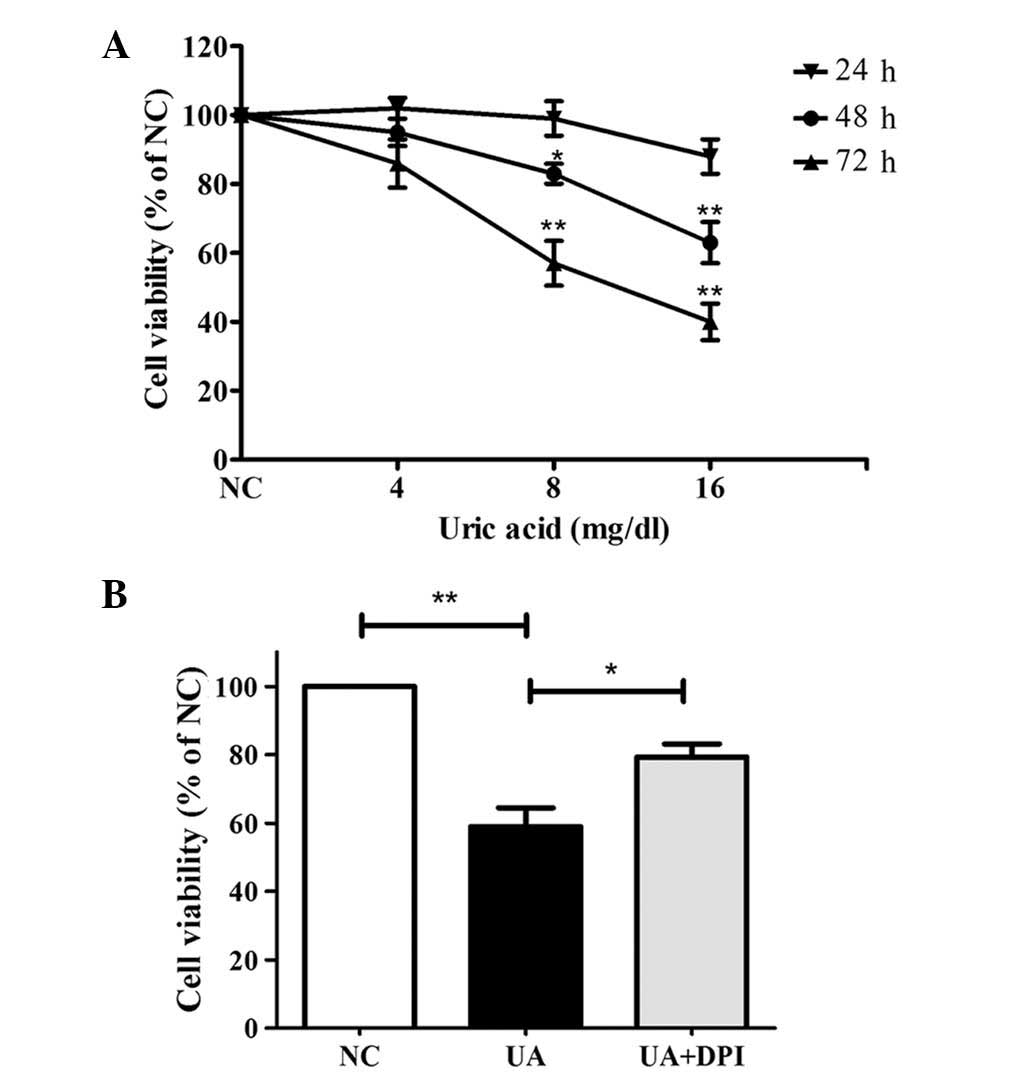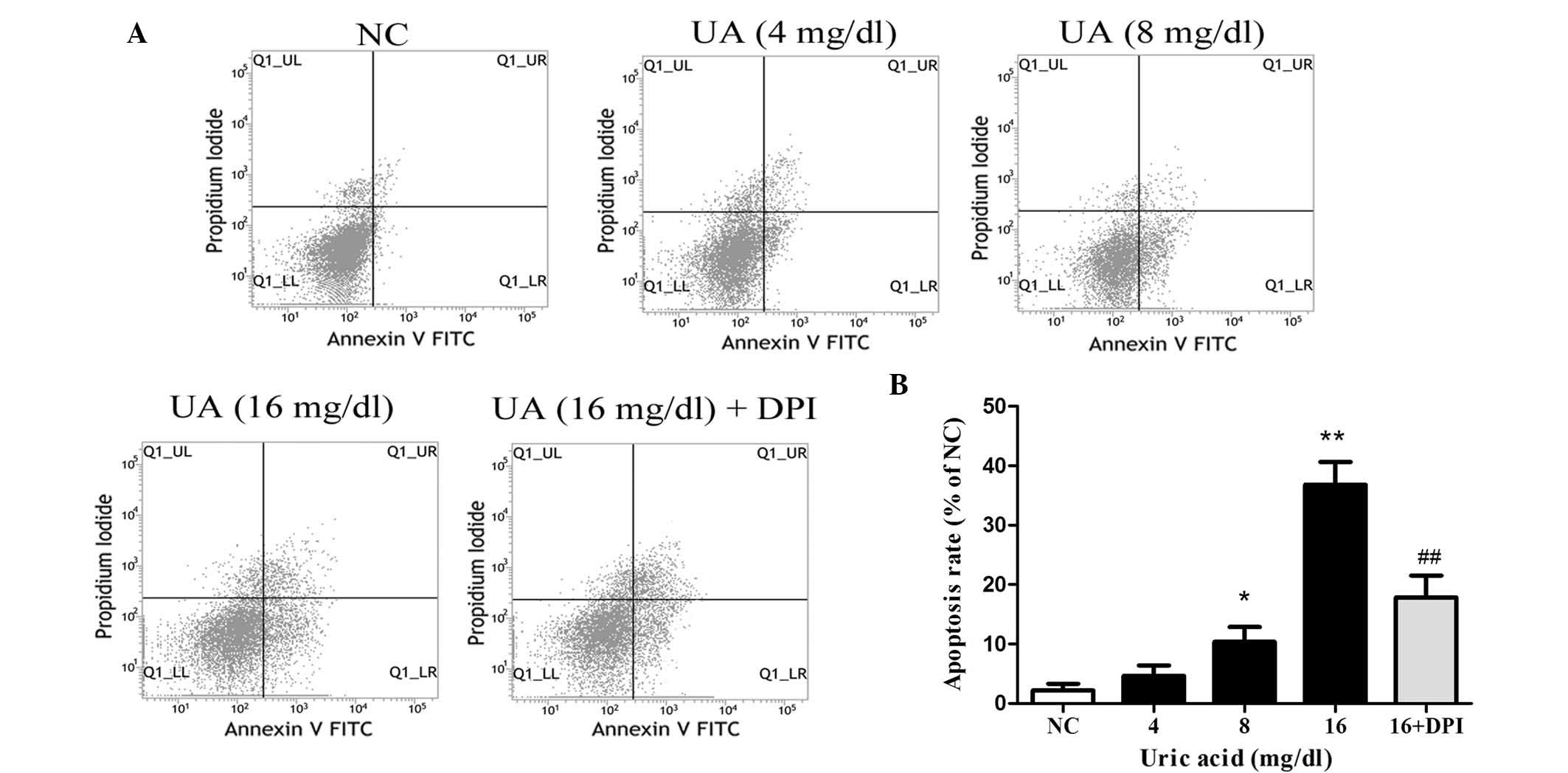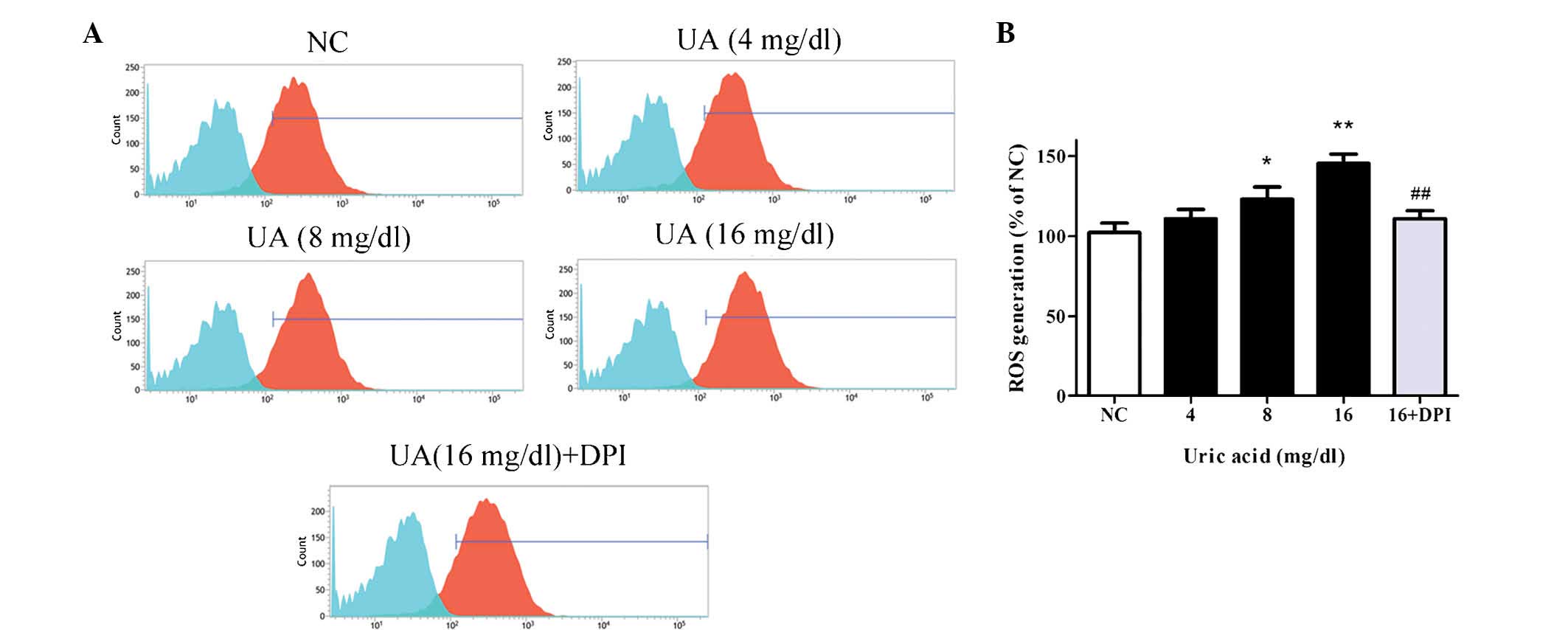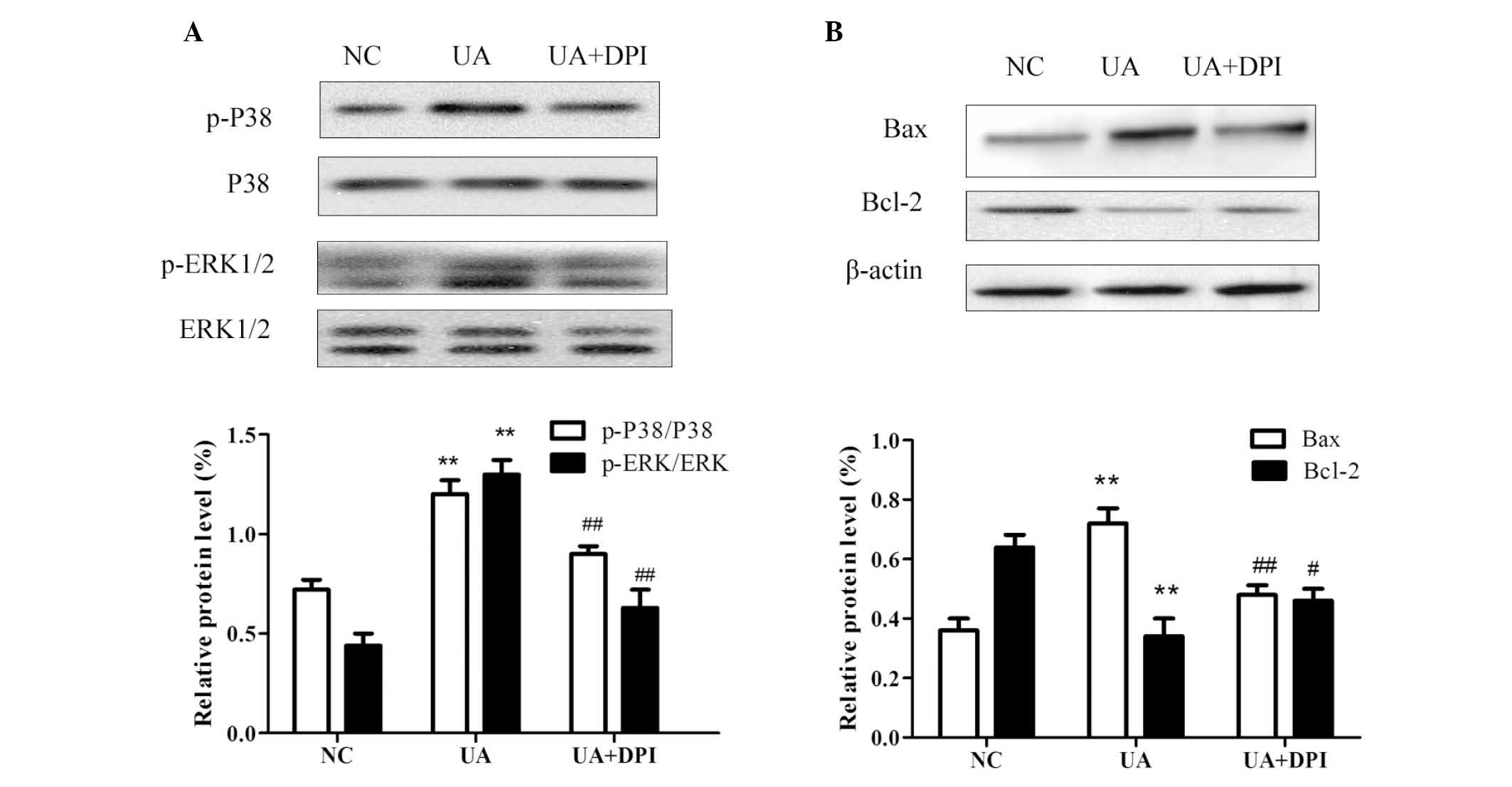|
1
|
Obermayr RP, Temml C, Gutjahr G,
Knechtelsdorfer M, Oberbauer R and Klauser-Braun R: Elevated uric
acid increases the risk for kidney disease. J Am Soc Nephrol.
19:2407–2413. 2008. View Article : Google Scholar : PubMed/NCBI
|
|
2
|
Johnson RJ, Nakagawa T, Jalal D,
Sánchez-Lozada LG, Kang DH and Ritz E: Uric acid and chronic kidney
disease: Which is chasing which? Nephrol Dial Transplant.
28:2221–2228. 2013. View Article : Google Scholar : PubMed/NCBI
|
|
3
|
Jin M, Yang F, Yang I, Yin Y, Luo JJ, Wang
H and Yang XF: Uric acid, hyperuricemia and vascular diseases.
Front Biosci (Landmark Ed). 17:656–669. 2012. View Article : Google Scholar
|
|
4
|
Convento MS, Pessoa E, Dalboni MA, Borges
FT and Schor N: Pro-inflammatory and oxidative effects of
noncrystalline uric acid in human mesangial cells: Contribution to
hyperuricemic glomerular damage. Urol Res. 39:21–27. 2011.
View Article : Google Scholar
|
|
5
|
Corry DB, Eslami P, Yamamoto K, Nyby MD,
Makino H and Tuck ML: Uric acid stimulates vascular smooth muscle
cell proliferation and oxidative stress via the vascular
renin-angiotensin system. J Hypertens. 26:269–275. 2008. View Article : Google Scholar : PubMed/NCBI
|
|
6
|
Zhang JX, Zhang YP, Wu QN and Chen B: Uric
acid induces oxidative stress via an activation of the
renin-angiotensin system in 3T3-L1 adipocytes. Endocrine.
48:135–142. 2015. View Article : Google Scholar
|
|
7
|
Ago T, Kuroda J, Pain J, Fu C, Li H and
Sadoshima J: Upregulation of Nox4 by hypertrophic stimuli promotes
apoptosis and mitochondrial dysfunction in cardiac myocytes. Circ
Res. 106:1253–1264. 2010. View Article : Google Scholar : PubMed/NCBI
|
|
8
|
Sedeek M, Nasrallah R, Touyz RM and Hébert
RL: NADPH oxidases, reactive oxygen species, and the kidney: Friend
and foe. J Am Soc Nephrol. 24:1512–1518. 2013. View Article : Google Scholar : PubMed/NCBI
|
|
9
|
Brown DI and Griendling KK: Regulation of
signal transduction by reactive oxygen species in the
cardiovascular system. Circ Res. 116:531–549. 2015. View Article : Google Scholar : PubMed/NCBI
|
|
10
|
Havasi A and Borkan SC: Apoptosis and
acute kidney injury. Kidney Int. 80:29–40. 2011. View Article : Google Scholar : PubMed/NCBI
|
|
11
|
Sharma K: Obesity, oxidative stress, and
fibrosis in chronic kidney disease. Kidney Int Suppl. 4:113–117.
2014. View Article : Google Scholar
|
|
12
|
Park J, Min JS, Kim B, Chae UB, Yun JW,
Choi MS, Kong IK, Chang KT and Lee DS: Mitochondrial ROS govern the
LPS-induced pro-inflammatory response in microglia cells by
regulating MAPK and NF-kB pathways. Neurosci Lett. 584:191–196.
2015. View Article : Google Scholar
|
|
13
|
Zhao ZY, Luan P, Huang SX, Xiao SH, Zhao
J, Zhang B, Gu BB, Pi RB and Liu J: Edaravone protects HT22 neurons
from H2O2-induced apoptosis by inhibiting the MAPK signaling
pathway. CNS Neurosci Ther. 19:163–169. 2013. View Article : Google Scholar
|
|
14
|
Changchien JJ, Chen YJ, Huang CH, Cheng
TL, Lin SR and Chang LS: Quinacrine induces apoptosis in human
leukemia K562 cells via p38 MAPK-elicited BCL2 down-regulation and
suppression of ERK/c-Jun-mediated BCL2L1 expression. Toxicol Appl
Pharmacol. 284:33–41. 2015. View Article : Google Scholar : PubMed/NCBI
|
|
15
|
Liu W, Ning R, Chen RN, Huang XF, Dai QS,
Hu JH, Wang YW, Wu LL, Xiong J, Hu G, et al: Aspafilioside B
induces G2/M cell cycle arrest and apoptosis by up-regulating H-Ras
and N-Ras via ERK and p38 MAPK signaling pathways in human hepatoma
HepG2 cells. Mol Carcinog. Feb 14–2015.Epub ahead of print.
|
|
16
|
Shi M, He X, Wei W, Wang J, Zhang T and
Shen X: Tenascin-C induces resistance to apoptosis in pancreatic
cancer cell through activation of ERK/NF-kB pathway. Apoptosis.
20:843–857. 2015. View Article : Google Scholar : PubMed/NCBI
|
|
17
|
Liu Y, Zhang S, Su D, Liu J, Cheng Y, Zou
L, Li W and Jiang Y: Inhibiting (pro)renin receptor-mediated p38
MAPK signaling decreases hypoxia/reoxygenation-induced apoptosis in
H9c2 cells. Mol Cell Biochem. 403:267–276. 2015. View Article : Google Scholar : PubMed/NCBI
|
|
18
|
Boban M, Kocic G, Radenkovic S, Pavlovic
R, Cvetkovic T, Deljanin-Ilic M, Ilic S, Bobana MD, Djindjic B,
Stojanovic D, et al: Circulating purine compounds, uric acid, and
xanthine oxidase/dehydrogenase relationship in essential
hypertension and end stage renal disease. Ren Fail. 36:613–618.
2014. View Article : Google Scholar : PubMed/NCBI
|
|
19
|
He T, Guan X, Wang S, Xiao T, Yang K, Xu
X, Wang J and Zhao J: Resveratrol prevents high glucose-induced
epithelial-mesenchymal transition in renal tubular epithelial cells
by inhibiting NADPH oxidase/ROS/ERK pathway. Mol Cell Endocrinol.
402:13–20. 2015. View Article : Google Scholar
|
|
20
|
Zhang Y, Yamamoto T, Hisatome I, Li Y,
Cheng W, Sun N, Cai B, Huang T, Zhu Y, Li Z, et al: Uric acid
induces oxidative stress and growth inhibition by activating
adenosine monophosphate-activated protein kinase and extracellular
signal-regulated kinase signal pathways in pancreatic β cells. Mol
Cell Endocrinol. 375:89–96. 2013. View Article : Google Scholar : PubMed/NCBI
|
|
21
|
Mouche S, Mkaddem SB, Wang W, Katic M,
Tseng YH, Carnesecchi S, Steger K, Foti M, Meier CA, Muzzin P, et
al: Reduced expression of the NADPH oxidase NOX4 is a hallmark of
adipocyte differentiation. Biochim Biophys Acta. 1773:1015–1027.
2007. View Article : Google Scholar : PubMed/NCBI
|
|
22
|
Kawahara T, Quinn MT and Lambeth JD:
Molecular evolution of the reactive oxygen-generating NADPH oxidase
(Nox/Duox) family of enzymes. BMC Evol Biol. 7:1092007. View Article : Google Scholar : PubMed/NCBI
|
|
23
|
Sedeek M, Callera G, Montezano A, Gutsol
A, Heitz F, Szyndralewiez C, Page P, Kennedy CR, Burns KD, Touyz RM
and Hébert RL: Critical role of Nox4-based NADPH oxidase in
glucose-induced oxidative stress in the kidney: Implications in
type 2 diabetic nephropathy. Am J Physiol Renal Physiol.
299:F1348–F1358. 2010. View Article : Google Scholar : PubMed/NCBI
|
|
24
|
Kim SM, Kim YG, Jeong KH, et al:
Angiotensin II-induced mitochondrial Nox4 is a major endogenous
source of oxidative stress in kidney tubular cells. PLoS One.
7:e397392012. View Article : Google Scholar : PubMed/NCBI
|
|
25
|
Oh SW, Lee ES, Kim S, Na KY, Chae DW, Kim
S and Chin HJ: Bilirubin attenuates the renal tubular injury by
inhibition of oxidative stress and apoptosis. BMC Nephrol.
14:1052013. View Article : Google Scholar : PubMed/NCBI
|
|
26
|
Qi W, Niu J, Qin Q, Qiao Z and Gu Y:
Glycated albumin triggers fibrosis and apoptosis via an NADPH
oxidase/Nox4-MAPK pathway-dependent mechanism in renal proximal
tubular cells. Mol Cell Endocrinol. 405:74–83. 2015. View Article : Google Scholar : PubMed/NCBI
|
|
27
|
Gao X, Wu J, Qian Y, et al: Oxidized
high-density lipoprotein impairs the function of human renal
proximal tubule epithelial cells through CD36. Int J Mol Med.
34:564–572. 2014.PubMed/NCBI
|
|
28
|
Jaiman S, Sharma AK, Singh K and Khanna D:
Signalling mechanisms involved in renal pathological changes during
cisplatin-induced nephropathy. Eur J Clin Pharmacol. 69:1863–1874.
2013. View Article : Google Scholar : PubMed/NCBI
|
|
29
|
Quan H, Peng X, Liu S, Bo F, Yang L, Huang
Z, Li H, Chen X and Di W: Differentially expressed protein profile
of renal tubule cell stimulated by elevated uric acid using SILAC
coupled to LC-MS. Cell Physiol Biochem. 27:91–98. 2011.PubMed/NCBI
|
|
30
|
Verzola D, Ratto E, Villaggio B, Parodi
EL, Pontremoli R, Garibotto G and Viazzi F: Uric acid promotes
apoptosis in human proximal tubule cells by oxidative stress and
the activation of NADPH oxidase NOX 4. PLoS One. 9:e1152102014.
View Article : Google Scholar : PubMed/NCBI
|














